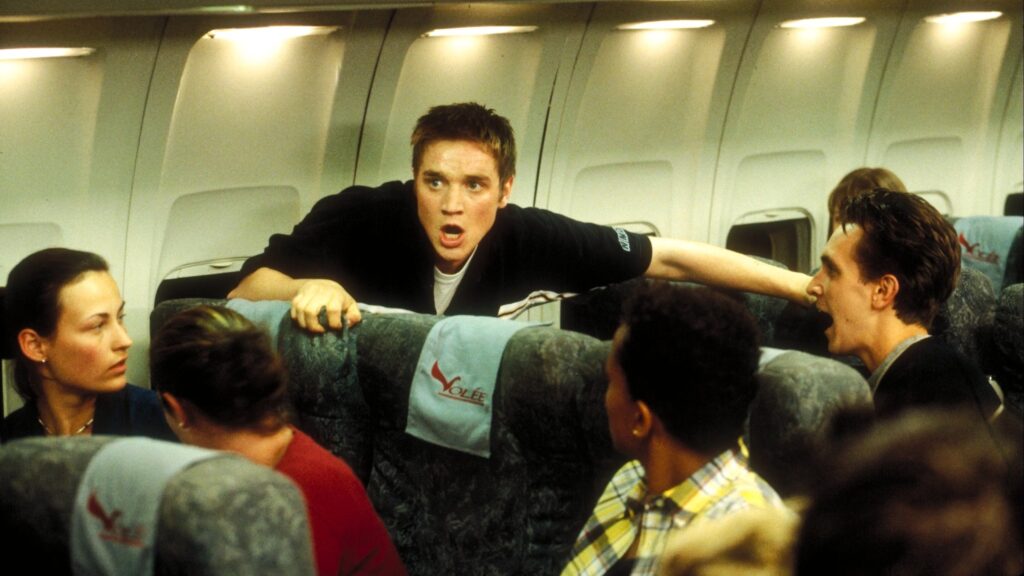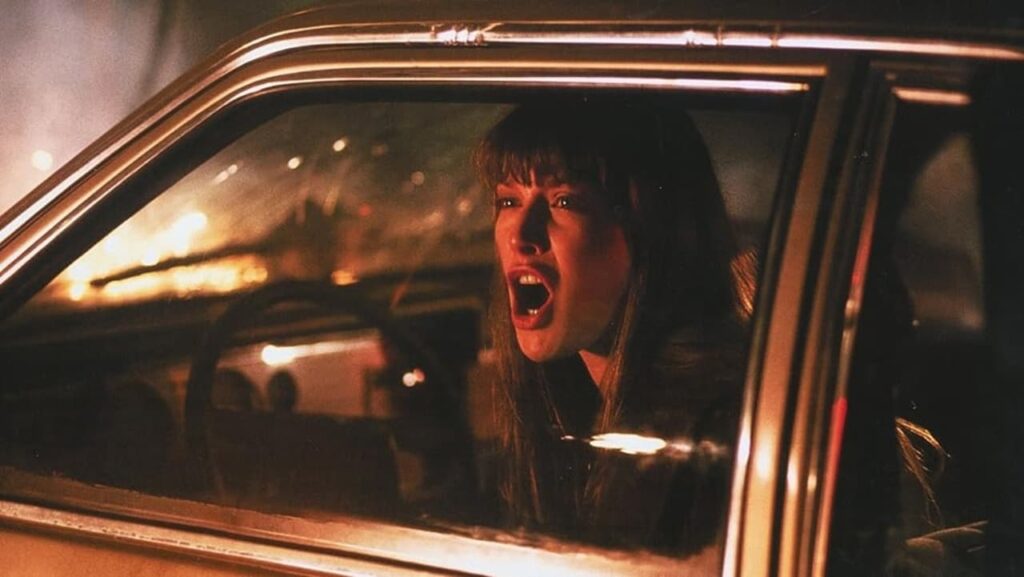No items, Fox only
Final Destination doesn’t wear the iconography of a slasher. But, in spirit, it distills and executes the format. To double-check my instincts, I pinged my online pal Brennan Klein, the slasher savant behind the outstanding Census Bloodbath series, which chronicles every ‘80s slasher in meticulous detail. He gave a definitive “for sure” when I asked if Final Destination fits the subgenre bill. “It’s got the group of victims, the variety of gory kills, and a single villain. Just because that villain is an amorphous entity doesn’t mean it’s not the killer,” he said. His answer was no shock to me — he’d already included it in his Slasher Primer list he generated in 2021, but it was nice to have my hunch confirmed.
In some ways, Final Destination is slasher cinema boiled down to its fatalistic bones. The killer isn’t a masked maniac with a cleaver — it’s Death itself, lurking unseen, felt only through gusts of wind, lightbulb flickers, and slow-dripping faucets. The closest we get to a hulking human form is when Tony Todd shows up as a grinning mortician to confirm our protagonists’ worst fears, but he’s a prophet of doom, not a murderer. Otherwise, Death never puts on a face here. The teens are pure slasher fodder: disposable, good-looking, and emotionally vacant. The common sex-as-death undertones are mostly absent. There’s no pretense about what’s at stake — this isn’t about sin as a mirror of mortality, just the cold inevitability of the big sleep. The thrills come not from traditional chases or a “shape” popping up around corners, but from the realization that you can’t bargain your way out of oblivion.
The film opens with high schooler Alex Browning (Devon Sawa) prepping for a flight to Paris with his classmates. As the plane boards, he’s gripped by a vivid premonition: the plane dissembles and explodes mid-takeoff, killing everyone on board, including himself and his friends. He causes a scene and gets kicked off the flight along with a handful of other students and a teacher. Moments later, the vision proves prophetic — the plane goes down in a fireball. Though his vision saved the lives of everyone booted from the jet pre-takeoff, Alex becomes a pariah, eyed suspiciously by classmates and FBI agents alike, as if he had something to do with it. Or maybe he just has the stink of damnation. Things get worse when the survivors start dying off in freak accidents, one after another.

Soon, Alex is playing reluctant detective, trying to decipher the logic of Death’s revenge. He’s joined by Clear Rivers (Ali Larter), and together they trace a grim chain of freak accidents: His premonition, whatever caused it, allowed a small group of people to cheat Death, and now it’s on their heels to restore order. Death, it turns out, is a patient and creative murderess, and Alex is desperate to find some kind of loophole before everyone around him ends up in a body bag.
It’s an absolutely terrific hook for a horror film: You escape death once, but now it’s stalking you. The setup gives the filmmakers carte blanche to stage a series of elaborate mousetrap death sequences without worrying about contrivance since the contrivance is the point, each demise its own little gimmick thriller. But the setup also centers the film around the primal dread of mortality. There’s no mystery or intrigue about who the killer is — just when, and how. Every swerving car, every spilled liquid, every misaligned mug on a shelf becomes a potential means of suffering and demise.
It takes more than a half hour, but once the promise of the premise clicks into place, the film ticks like clockwork. The rhythm: We get a stretch of ominous dialogue theorizing — who’s next, how does Death work, can it be stopped? — followed by a deathwatch montage where every innocuous, everyday object gains horrifying gravity. James Wong directs with a magician’s flair for misdirection and climbing suspense, doling out the deaths with a variety of timing and twists.

It’s not surprising but still too bad the characters are such thin sketches, because a little more color and humor might’ve elevated the whole thing. Sawa scowls and spirals with a kind of generic anxiety; he’s less lively than he was in Idle Hands, though still up for carrying a film like this. Seann William Scott injects some goofy charisma as the resident doofus, but he’s barely in it long enough to make a dent. Ali Larter pines and broods. The others exist mostly to be props in death scenes of approximately ascending order of brutality. (They also all have stupid and distracting character names inspired by famous horror movie figures. This will almost surely bother you more than it bothers me, as I tend to forget character names 10 seconds after I first hear them, but come on: Billy Hitchcock?)
The screenplay fares better when it keeps the story simple and the dialogue soaked in death-flavored deadpan. The second half of the story builds a conspiracy around who will next die based on airplane seating, which is a fussy, confusing, and unconvincing device to my impatient ears. I liked it more when it was all about Alex’s premonitions. I also enjoyed whenever the characters were shouting at each other about how death is unfair, why is this happening to them, etc., though even that is more thematic filler between the death scenes than anything of philosophical depth. There’s frankly not a single quotable line in the whole runtime — and that’s ultimately not much of a problem for a movie with this purpose.
For most of the film, Final Destination has a tone I really enjoy: Its DNA has some black comedy — not postmodern or quippy like Scream, instead leveraging physical mayhem. It’s the Looney Tunes of horror series. It tilts more towards thriller than comedy among the slick, post-Scream, teen-focused horror flicks. The opening plane crash premonition is white-knuckle: a frightening, almost Fincher-esque set piece that sets the bar for suspense quite high. Wong keeps the tone taut and ominous, and really leans into making everyday experiences dangerous. He turns Final Destination into “Intrusive Thoughts: The Movie,” which turns out to be the right space to be in.

The deaths themselves sometimes verge into Rube Goldberg machine territory. Here are my spoilery reviews of each death sequence:
- The plane crash – as mentioned, it’s an excellent setup disaster sequence even if it’s uncharacteristic of the rest of the film.
- Tod (Chad E. Donella) – Slips and hangs himself with a shower cord. I’m not wild about the way the film visualizes Death here: The creeping blue liquid is more physically manifest than elsewhere, but it at least primes the viewers to understand that a mystical, unstoppable force is behind the mutilation we witness. Tod’s bugging eyes during his suffocation are unsettling and his desperation to break free of his strangulation is palpable, but this is on the straightforward side of the film’s deaths.
- Terry (Amanda Detmer) – Abruptly hit by a bus. The death itself is very simple, but the pleasure is all in the abrupt comic timing and juxtaposition of Terry and Carter planning to run off. Made me laugh.
- Ms. Lewton (Kristen Cloke) – This is the film’s real triumph of multi-step gadget murder, a fire-and-knife combo platter. It verges into brutal and torturey, but all the moving pieces required to get Ms. Lewton’s house burning and her flesh stabbed are well-orchestrated. I like the image of Alex holding the knife at the end, as it hints at an idea otherwise not explored by the film: That Alex has a subconscious thrill and desire to take part in the killing himself.
- Billy (Scott) – The funniest misdirection in the movie — after Carter narrowly avoids an incoming train, a flying piece of metal decapitates Billy and a hilarious prop melon boucnes around the ground.
- Clear (Larter) – Her spotlight scene makes her the “final girl,” nearly avoiding death multiple times like Laurie Strode. This one tries to build too much ominous dread and ends up getting silly: A sparking, downed power-line crosses paths with an above-ground pool, and also a burning bottle of turpentine. The goofiest part is when the electric shock is almost literally chasing Clear through a house, light bulbs shattering just a step or two behind her.
- Carter (Kerr Smith) – The movie-wrapping peek-a-boo death, which I understand to be a series staple. An overconfident Carter gets clobbered by a giant swinging metal sign in Paris, death soaring back at him like a pendulum. Cut to black.

No one’s going to confuse this for a prestige horror flick; it’s squarely Friday night popcorn genre fare. But in terms of design and execution, it borders on elegant: a simple premise, tightly wound, iterated through with precise flair and just enough variation and creativity to sustain its idea to feature length. It’s no wonder the film launched five sequels and counting. I’ll take this sort of entertaining fatalism over nihilistic, transgressive dread-mongers like The Texas Chain Saw Massacre.
At Final Destination’s core is something endearingly human: the film wants its characters to survive, even as it gleefully snuffs them out. Beneath the violence and suspense, it’s a movie about clinging to life — grasping for one more breath, one more tomorrow — which is strangely comforting and optimistic even in the movie’s cruelty.
Back to my opening investigation: who really cares whether Final Destination fits neatly into the “slasher” box? Arguing genre taxonomy in the face of such an effective teen horror-thriller feels like wasted digital ink. This is a movie that taps into something primal and inescapable: the knowledge that death is coming, and all our cleverness and luck can only stall it. Call it a slasher, a thriller, teen anxiety manifest, or a John Denver murder symphony — whatever you want. If it makes your heart pound and your skin crawl, if it so effectively forces you to acknowledge head-on that death will come for us all… that’s great horror in a nutshell.
Is It Good?
Very Good (6/8)
Dan is the founder and head critic of The Goods. Follow Dan on Letterboxd. Join the Discord for updates and discussion.

